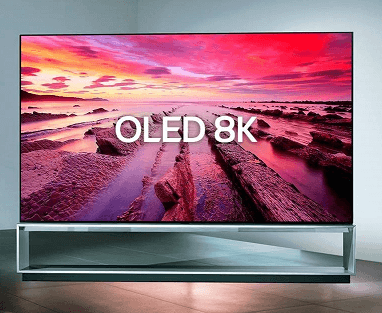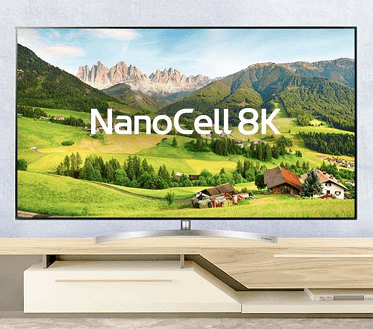We will also see the differences between OLED and NanoCell TVs with respect to some important specifications (display type, viewing angles, burn-in, etc.). Finally, we will try to figure out which is the best for you in OLED vs NanoCell. So, let’s get started.
What is OLED TV?
OLED is short for Organic Light Emitting Diode. Even though it has the term LED (light emitting diode) in it, OLED is primarily used as display technology and rarely as a lighting source. The standout feature of OLED display is that the panel itself acts as light source. Each pixel (the smallest display element) in an OLED TV can emit its own light. This is in contrast to the popular LCD TVs, which require a separate source of backlight (previously fluorescent lamps but almost all modern LCD TVs use LEDs for backlight) to illuminate the pixels. So, OLED TVs doesn’t require any backlight as they can produce their own light. What are the benefits of this? As each pixel emits its own light, we can control each pixel to turn OFF during dark scenes to produce stunning blacks. The rest of the image displays its own colors but the dark parts of the images will be completely dark. This improves the contrast of the display and there is no problem of backlight bleeding in OLEDs. Another important benefit of OLED is viewing angles. For LCD TVs, viewing angles has always been a problem, where you have to sit significantly straight in front of the TV and if not the colors of the image look washed out.
What is NanoCell TV?
NanoCell TV is a type of LCD / LED TV from LG, particularly their IPS panel LCD TVs. Before understanding NanoCell technology, let us first take a quick look at IPS technology (In-plane Switching). Earlier LCD TVs used vertical alignment of liquid crystal. Due to this, if you sit slightly off-center from the TV, the picture quality appears low and also the colors on the TV looked washed away. In IPS technology, the alignment of liquid crystals is altered from vertical to horizontal. The result of this alignment is a dramatic improvement in viewing angle and also a better color reproduction. So, even if you sit off-center from the TV, the picture quality will still be great and loss of quality is very less. If IPS is already better than previous LCD technologies, what is the use of NanoCell technology? Even though IPS fixes the viewing angle problem of LCD TVs, the colors produced by an LCD TV are still not the best. NanoCell TVs use nano particles at individual pixels and they absorb unwanted light to enhance the primary Red, Green and Blue colors on the screen. The result is deeper colors, sharper tones and an overall wider color palette that produces lifelike colors and sharper pictures at all viewing angles.
Pros and Cons of OLED and NanoCell
Pros of OLED
Stunning black levels Extremely thin TVs, in fact one of the thinnest available right now Very wide viewing angles
Cons of OLED
Expensive Burn-in problem Less peak brightness than LCD TVs
Pros of Nano Cell
Improved color reproduction from regular IPS LCD TVs Affordable than OLED but slightly expensive than regular LCD TVs Good for HDR content due to higher peak brightness than OLED TVs
Cons of Nano Cell
As they are essentially LCD TVs, you won’t get perfect blacks Slightly thicker and heavier than OLED TVs
Recommended OLED TVs
LG C1 55-inch 4K Smart OLED TV The 55-inch LG C1 OLED TV is one of the top-selling and top-rated OLED TVs in the market. It is a 4K TV that has a native refresh rate of 120Hz. It is also gamer friendly with both Free-Sync and G-Sync compatibility, less than 1ms response time and support for Variable Refresh Rate (VRR). It is definitely a value for money OLED TV from LG. Sony BRAVIA XR A80J 55 Inch 4K OLED TV A successor to the previously successful A8H, the Sony A80J is another highly recommended OLED TV. It is a 4K TV that supports HDMI 2.1, 120Hz refresh rate, VRR and has many other features. It is suitable for watching games and also playing games.
Recommended NanoCell TVs
As NanoCell is essentially an LG proprietary technology, all Nano Cell TVs are from LG. There are three main series of NanoCell TVs from LG LG Nano90 4K NanoCell (available in 86”, 75”, 65” and 55”) LG Nano80 4K NanoCell (available in 75”, 65”, 55” and 50”) LG Nano75 4K NanoCell (available in 86”, 75”, 65” and 55”) Of the three, only Nano90 series of TC have full array local dimming while Nano80 series has regular local dimming and the Nano75 series doesn’t have any local diming at all. Also, Nano90 series has native 120Hz refresh rate, while the remining two have only 60Hz native refresh rate. The 55” Nano90 NanoCell TV is cheaper than the 55” OLED TV mentioned earlier.
OLED vs Nano Cell: Comparison Table
Let us now compare OLED vs Nano Cell with respect to some important parameters that are key when buying a TV.
Difference Between OLED vs Nano Cell
Expanding on the above comparison table, let us now see the differences between OLED and NanoCell TVs.
Display Type
OLED TVs, due to their self-emitting pixels, are called as Emissive Displays where as NanoCell TVs, which are a flavor of LCD TVs with LED backlighting are called as Transmissive Displays.
Viewing Angles
If you have your friends or family around to watch a new movie or a TV Show, then you don’t have to fight to take the spot straight in-front of the TV, either it is an OLED or a NanoCell as they both essentially have wide viewing angles. That being said, if you compare between OLED and NanoCell, OLED is clear winner in terms of viewing angles and color accuracy at wider viewing angles due to their self-emitting pixels.
Color Accuracy
Both OLED and NanoCell TVs have excellent color accuracy and the main concept of NanoCell is to improve the color quality of the picture and make it as perfect as an OLED TV.
Contrast
As the pixels are switched off for black colors, OLED TVs have a very large contrast ratio compared to NanoCell TVs.
Black Levels and Dimming
Again, OLED is the clear winner here, both in terms of deep black levels and also individual pixel dimming. But NanoCell TVs with full array local dimming are also excellent at dimming but the black levels are still greyish when compared to OLEDs.
Response Time
This is an important specification if you want to play games on your TV. Response time of a display is the time between switching from one color to other, usually grey to grey or black to white. OLED TVs have one of the lowest response times out there with values as low as 1ms. NanoCell TVs are also good but the response times are between 5ms to 10ms.
Burn-in Problem
One main concern of OLED TVs is burn-in. It is a situation where the display permanently displays one image (usually a news channel logo or something similar) at a location if it is displayed for too long. You have to be worried about burn-in problem in OLED TVs if you watch content with static images on screen (such as new channels) for a continuous period. That being said, modern OLED TVs are less prone to burn-in with a screen shifter technology. NanoCell TVs on the other hand doesn’t have a burn-in problem at all.
Screen Thickness
As there is no backlight system and also the number of layers in the actual display panel are very less, OLED TVs can be made very thin and in fact LG’s Wallpaper TV Series is one of the slimmest TVs available, where the thickness of the display is just a couple of millimeters. NanoCell TV, just like LCD TVs, must have backlight system and as a result, they are usually thicker in size.
Cost
The last and the important factor is the cost of OLED vs NanoCell TVs. LCD TVs have become quite popular over the years and the manufacturing cost also came down significantly. As a result, the cost of NanoCell TVs is significantly lower than OLED TVs. Speaking of OLED TVs, they are still considered a luxury in some markets. They are expensive but the price of some variants of OLED TVs are coming down.
Conclusion: OLED vs Nano Cell – Which is Better?
Finally, which TV is better: OLED or NanoCell? If you want ultimate picture quality with stunning black levels, then there is no other TV as OLED. The vibrant colors, individual pixel level control, deep blacks allow you to have the ultimate movie watching experience. If you are a gamer, then OLED TVs offer you with good visuals, low input lag and fast response times. The main problem with OLED TVs is the cost. You have to spend a little extra to get all these features. NanoCell TVs on the other hand also have good color accuracy and viewing angles (even though they are less than OLED counterparts). For watching movies, we recommend NanoCell TVs with full array local dimming. LCD TVs in genera have higher peak brightness than OLED TVs and hence watching HDR content on NanoCell TV will be amazing. Comment * Name * Email * Website
Δ







![]()